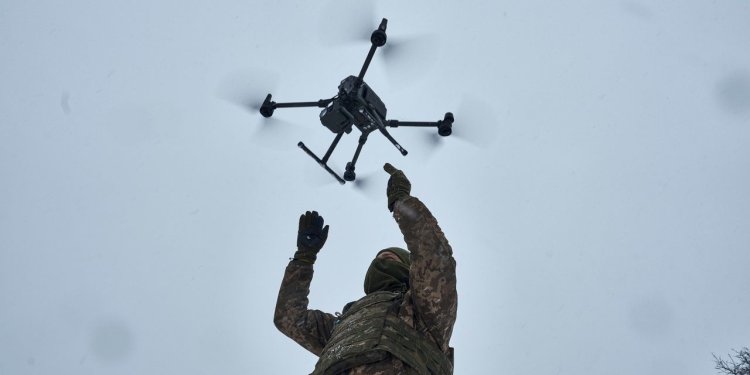Ukraine Needs American Drones
China’s export controls on the unmanned aerial systems Kyiv uses will benefit Russia in the war. By Seth Cropsey Aug. 6, 2023 3:42 pm ET A Ukrainian soldier launches a drone near Avdiivka, Ukraine, Feb. 17. Photo: LIBKOS/Associated Press China’s recent decision to restrict exports of drones will blind Ukraine’s reconnaissance advantage in the war with Russia and constitutes an active intervention on Moscow’s side. The U.S. and its allies should respond by developing an industrial base that makes unmanned aerial systems. Failing to do so would all but guarantee that Russia gains the upper hand. The Ukraine war is the first drone war. Unmanned aerial systems, or UAS, are crucial to Ukraine’s strategy and are at the forefront of a transition in military technology that closes the gap between the potential and actual effect of preci


A Ukrainian soldier launches a drone near Avdiivka, Ukraine, Feb. 17.
Photo: LIBKOS/Associated Press
China’s recent decision to restrict exports of drones will blind Ukraine’s reconnaissance advantage in the war with Russia and constitutes an active intervention on Moscow’s side. The U.S. and its allies should respond by developing an industrial base that makes unmanned aerial systems. Failing to do so would all but guarantee that Russia gains the upper hand.
The Ukraine war is the first drone war. Unmanned aerial systems, or UAS, are crucial to Ukraine’s strategy and are at the forefront of a transition in military technology that closes the gap between the potential and actual effect of precision-guided munitions. Modern militaries have fielded extraordinarily accurate weapons for decades. First employed during the U.S. bombing campaign in the 1972 Easter Offensive in Vietnam, precision weapons have become increasingly accurate and long-range. But accuracy is useful only if a target can be identified and rapidly engaged.
Unmanned aerial systems also are fixtures of modern militaries, first used in 1982 at large scale to operational effect in suppressing Syrian air defenses in Lebanon. They searched for long-range heavy guns during the Gulf War and were used by the U.S. and its allies as a key strike asset against jihadists during the global war on terrorism.
Ukraine’s military success represents an evolution beyond standard Western—and, before the current war, standard Russian—military practices. Outmanned and outgunned, the Ukrainians face an enemy with far more cannons, rocket launchers and ammunition. Their solution, developed since the 2014 Donbas war began, has been to fight smarter.
The Ukrainian UAS reconnaissance system integrates a handful of weapons with tens of thousands of small drones, including handheld machines, larger, four-rotored quadcopters and a handful of fixed-wing craft. Ukrainian UAS units drive forward, deploying drones within a few hundred yards of the enemy. Starlink satellites transmit real-time images of Russian units. This live battlefield data, which the Russian military struggles to disrupt, is fed back to artillery units. When a target is engaged, Ukraine’s drone operators can fire weapons and assess the battle damage immediately. This system enables strikes deep into the Russian forces by deploying long-range artillery fire to destroy air defenses, electronic systems, and other high-value targets.
Every month, Ukraine uses about 10,000 drones of different types. Loss rates vary. Experienced operators might take the same drone on dozens of missions, while infantry units in hot spots could lose drones each day of combat. Russia has copied Ukraine’s system, using the same equipment, but less effectively. Russian forces typically use less mobile but more reliable wired communications platforms.
Most drones are made for civilian use. Before the Ukraine war, no defense contractor had the capacity to supply UAS at the scale required for combat. Chinese state-backed company DJI is the world leader, making up about two-thirds of the global small drone market. Ukrainian soldiers prefer DJI equipment to American and European alternatives, which cost more and are often less user-friendly and reliable. A short-range DJI quadcopter sells for between $1,000 and $5,000; a medium-range one for $5,000 to $15,000. Because DJI is a state-funded entity, the Chinese Communist Party and Ministry of State Security have extensive insight into its exports.
China has disrupted Ukrainian drone deployment before. Throughout 2022, it delayed quadcopter exports to the European Union while still complying with EU market regulations and limiting the capabilities of its Aeroscope UAS detection systems. But with the export controls announced last week, China instituted a review process for any drone sales that pass a certain threshold, essentially regulating ones with military use. The key part is a ban on military end-use. Ukraine gets most of its drones through individual buyers and charities that operate in Europe, meaning after Sept. 1, when China’s export controls go into effect, it will be hard for Ukrainian units to get Chinese-made drones.
This is intervention on Russia’s behalf. China is unlikely to restrict drone-technology transfers to Russia. Even if it does so nominally, it has almost certainly helped Russia build a small but useful domestic drone industry by exporting consumer electronics that Russia can repurpose into low-tech UAS.
A wholesale ban would overwhelmingly benefit Russia. Despite severe attrition, Russia has quantitative artillery superiority over Ukraine, while Ukraine’s entire approach rests on integrating drones with artillery fire and infantry movement. If the conflict reverted to a 20th-century contest between massed artillery, Russia would have an overwhelming advantage. Without the reconnaissance edge, Ukrainian offensives would be impossible. As Ukrainian counterbattery fire deteriorates, Russian forces can simply grind Ukraine down.
The West can’t sustain Ukraine in a traditional fight. While Western artillery capacity is expanding and can meet Ukraine’s needs without dipping into stockpiles over the next 15 months, Ukrainian ammunition expenditure is premised on its UAS-reconnaissance system. The West would need to supply Ukraine with not 120,000 to 150,000 shells a month, but closer to half a million, and with 1,000 or more additional guns.
China’s actions demand a recognition from the U.S., its allies and Ukraine that Beijing is a full, if stealthy, supporter of Russia’s war. China has no desire to play honest broker, nor any interest in seeing a settlement that respects American, European or Ukrainian security concerns.
The U.S. and its allies must act immediately. Drone makers in the West are eager to compete with DJI and other Chinese companies. The U.S. should repurpose some of its aid to Ukraine to include quadcopters made by U.S. companies.
The defense secretary can initiate an emergency program under the Defense Department’s Rapid Acquisition Authority. This authority, which lets the secretary appropriate funds from almost any source in the Pentagon budget, applies when a “compelling national security need” demands “the immediate initiation of a project” and “rapid fielding.” The need is obvious: American support to Ukraine will fail if the UAS-reconnaissance system collapses.
The Biden administration has supported Ukraine thus far by delivering piecemeal capabilities weeks to months after its need became apparent. Ukraine has survived thanks to ingenuity and technological adaptation, particularly by using UAS to improve its artillery. If Ukraine doesn’t get the UAS support it needs, Russia will gain the upper hand, likely by year end. If the U.S. doesn’t act, it risks handing a decisive victory to Russia—and a geopolitical gain to China.
Mr. Cropsey is founder and president of the Yorktown Institute. He served as a naval officer and as deputy undersecretary of the Navy and is author of “Mayday” and “Seablindness.”
Wonder Land: At the center of the legal problems now engulfing Donald Trump and Hunter Biden is the refrain that no one is above the law. Wagner Group's Yevgeny Prigozhin offers the alternative: No rules. Images: AP/AFP/Getty Images Composite: Mark Kelly The Wall Street Journal Interactive Edition
What's Your Reaction?

















